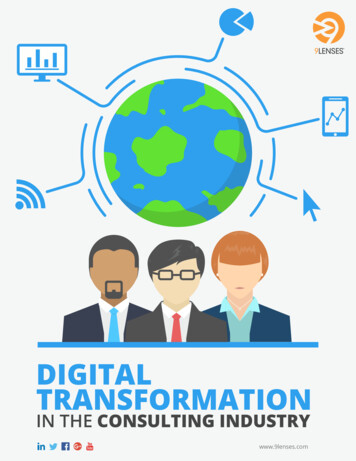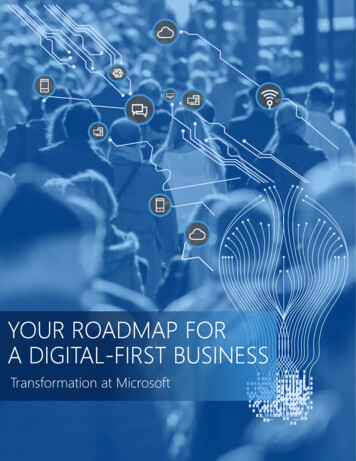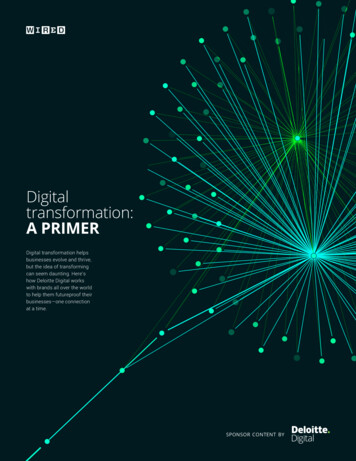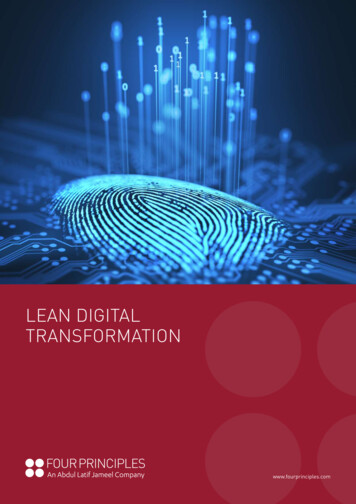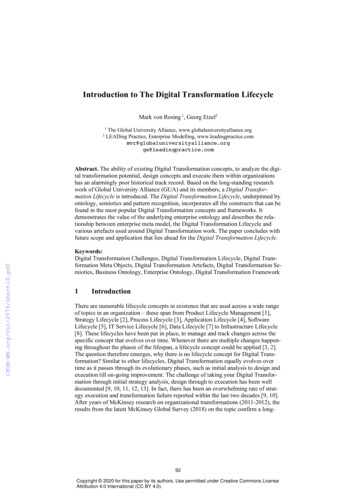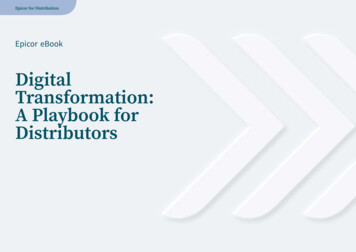
Transcription
Co-Creation:A DigitalTransformationAdoption Tool#GoodTechIBM
Co-Creation: A Digital Transformation Adoption Tool2HighlightsThis white paper describes how organizations can use co-creation internallyas a tool to achieve a successful digital transformation.Content overviewCo-creation: The Present4Using Co-creation for InternalTransformation5Personalize the EmployeeExperience5Activate Employees duringTransformation6Produce Great Ideas7Conclusion10
3IBM Corporate Social ResponsibilityExecutive abstractOrganizations no longer question if they need to undertakea digital transformation journey, but how they can do sosuccessfully. While the payoff of digital transformationremains high, the success rate is relatively low. Out ofthe 1,000 companies surveyed on digital readiness, only5% reported they achieved or exceeded expectations duringdigital transformation efforts. Where does this disconnectstem from? Developing a strategy is only the beginningof digital transformation. Implementing this strategyto effectively take hold within an organization presentsthe real challenge.1IBM uses co-creation as a tool to implement digitaltransformation initiatives. This well-regarded tool hasbeen widely used to invite customer collaboration intoproduct design. However, co-creation can also be used duringtransformation efforts to connect leadership with employeesand shape change decisions together. This paper outlinestwo case studies to demonstrate the value of co-creating:1) Starbucks co-creating with customers via theMy Ideas platform2) IBM co-creating with employees via a web-baseddiscussion forumUsing co-creation as a tool to facilitate digital transformationresults in:— A personalized employee experience and abilityto activate the employee population— Great ideas and key insights to stay competitivein a volatile environment— Employee buy-in during a period of accelerated change—1 Baculard, Laurent-Pierre, and Colombani, Laurent, and Flam, Virginie, and Lancry,Ouriel, and Spaulding, Elizabeth. (November 22, 2017). Orchestrating a SuccessfulDigital Transformation. Bain&Company.
Co-Creation: A Digital Transformation Adoption ToolCo-creation:The Present4Case Study:My StarbucksCo-creation has been successfully used many timesto collaborate with customers to design new products,however can this framework accomplish more? Co-creation’ssuccess can be attributed to its triumph over traditionalresearch techniques. Traditional methods rely on staticsurvey tools, while co-creation engages people in a robustand dynamic discussion. A shared discussion betweencustomers and companies at scale produces valuable insights.This experience is far more immersive for participants andprovides a space for creativity to prosper, ideas to grow,and alignment or adoption to be achieved. A successfulco-creation exercise is structured by three tenets: 1) Selection participation – Co-creation exercises beginby targeting and identifying the audience most relevantto the discussion 2) Early transparency – Participants are informed of theexercise’s intentions. Throughout the exercise, outcomesare communicated to participants on how they are beingused to shape design decisions. 3) Differentiated involvement – While reviewing outcomes,ensure a diverse pool of expertise from a variety ofsources. This creates comprehensive and unbiasedperspectives.2Through co-creation exercises, organizations are ableto reach out to individuals at scale in a structured mannerto collect and synthesize feedback on specific topics andco-create a solution. Starbucks demonstrated the benefitsto co-creation in their exercise “My Starbucks”.“My Starbucks” launched in 2008 and engaged customersthrough a web-based platform. Customers simply createda profile and submitted their ideas for others to comment.What made this exercise more than a suggestion boxwas the voting, commenting, and collaboration over ideas.Starbucks actively managed this platform and communicatedwith customers, resulting in increased customer loyaltyand greater product diversity. In the first five years theplatform operated, customers submitted over 150,000 ideas.277 ideas were brought to life including Starbucks productstaples such as pumpkin spice lattes, cake pops, happy hours,and free birthday treats. The greatest benefit this co-creationexercise brought Starbucks was access to new and potentiallyvaluable ideas. In addition, Starbucks received mediaattention, free advertising, and a market research tool intotheir customer demographic. Customers, on the other hand,were able to voice their ideas and influence the directionof their favorite establishment.3——2 CEB. (2016). Cocreate Change Strategy.3 Fournier, Alexis. (March 20, 2019). My Starbucks Idea: An Open Innovation Case-Study.
5IBM Corporate Social ResponsibilityUsing Co-creation for Internal TransformationPersonalize the Employee ExperienceThe strong benefits of co-creation have been demonstratedthrough customer engagements and can also be adaptedand used with employees during internal transformations.While soliciting employee input is a widely agreed upontransformation technique, co-creation moves beyond simpleengagement and allows leadership to mutually design, shape,and share ownership of the final product, helping employeesto feel part of the dialogue. While the concept of solicitingemployee feedback in principle is quite simple, the executioncan be difficult, particularly at global scale. Management oftenasks for input too late and underestimates the effort requiredto conduct feedback sessions to truly influence decisionmaking. Management may try to shortcut this process throughtown halls and annual surveys. While these techniquesproduce some results, they ultimately have limited impacton employees embracing change. On the other end of thespectrum, too many participants providing feedback causesopinion overload leading to slow decision-making.4Co-creation exercises identify how to cultivate a positiveemployee experience through which organizations are ableto better understand their people and achieve strongerbusiness results. By shifting traditional thinking beyondjust employee engagement to employee experience,companies will be able to more effectively manage theirpeople and enable them for success. Gartner defines theemployee experience as “employees’ perceptions andrelated feelings caused by the one-off and cumulative effectof interactions with their employer’s customers, leaders,teams, processes, policies, tools, and work environment.” 5This holistic approach to workplace culture and employeeexperience helps companies better understand their people.Through achieving a greater understanding, enterprises willalso produce stronger business results. According to MITresearch:Striking the balance of including the right people, at theright time, and in the right way is challenging. Throughthe methodology of co-creation, organizations can gatherinput from across their teams to design, test, and launchinnovative programs. Using co-creation to facilitate internaltransformation allows organizations to 1) Personalize the Employee Experience 2) Activate Employees during Transformation3) Produce great ideas “Enterprises with a top-quartileemployee experience achieve twicethe innovation, double the customersatisfaction, and 25 percent higherprofits than organizations witha bottom-quartile employeeexperience.” 6Iterating directly with employees produces stronger businessresults, a network of change agents, and unparalleledinnovation. These three benefits increase transformationstrategy adoption within an organization. This user-centricapproach produces a diverse set of insights and allowsleadership to connect with employees, accomplishingmore together than either one is able to alone.——5 Gartner. (2019). Employee Experience.4 CEB. (2016). Cocreate Change Strategy.6 Deloitte. (2019). From Employee Experience to Human Experience. 2019 Deloitte HumanCapital Trends.
Co-Creation: A Digital Transformation Adoption ToolWhile these business results are impressive, they are alsodifficult to achieve. Only 9% of Deloitte’s 2019 HumanCapital Survey respondents believed they were ready toaddress the challenge of improving employee experience.7How can organizations tackle employee experience in astrategic manner? The IBM Talent and Change team addressedthis question by conducting a thorough interview exercisewith Human Resources thought leaders. Through theirresearch, IBM Talent and Change identified personalizationas a key practice to improve employee experience.Personalizing the employee experience creates a fitbetween the needs of the employee and the needs of theorganization.8 This agrees to neither putting the employeenor the organization before the other. Ultimately, productivitywill flourish by joining together to achieve goals in tandem.Conducting co-creation exercises uncovers how to personalizethe employee experience. A structured exercise betweenmanagement and employees at scale allows the employeeto speak from their perspective and management toincorporate these workforce differences into transformationefforts. One size does not fit all. Once companies haveexpanded their definition of engagement to include thewhole employee experience, they need to identify how toreach employees and create a network of change agents.6ActivateEmployees duringTransformationFacilitating a co-creation exercise identifies the mostactive employees within an organization. A large barrierto implementing strategy within organizations, particularlylarge ones, is reaching the employees. Employee activationplays an important role in combating the natural formationof change resistant silos to foster an open and transparentculture. Activation refers to the way organizations encourageand communicate with their employees. The first step toemployee activation is identifying how to communicate withemployees. Once communication channels are established,employers should consistently seek to improve thesemethods, ensure they are effective, and strive to reachnew audiences. The initial goal of activation is to captureemployee interest and empower employees to take actionin areas outside their direct job function. The ultimate goalenlists employees as organization champions to encourageparticipation amongst their peers. When employeesare active, they become more engaged, more productive, andhelp establish the business as a trustworthy, authentic brand.9Identifying these individuals can be particularly difficult.The first step in a co-creation exercise is selecting participants.After the exercise completes, management can analyzeparticipation to identify the most active employees andcontinue utilizing these individuals. These active employeesare imperative to the betterment of an organization,as they often also voice the greatest ideas.—7 Ibedem.8 IBM Institute for Business Value.(2016). Designing the Employee Experience. Capital Trends.—9 Brenner, Michael. (June 18, 2018). What Is Employee Activation? Marketing Insider Group.
7ProduceGreat IdeasBain & Company surveyed 1,000 companies on digitalreadiness and only 5% rated their digital transformationsas achieving or exceeding expectations. Innovation is amandatory component to achieve this 5% success. Thisstudy also confirmed the best ideas come from deep withinthe organization, but their successful execution depends onthe ability of top executives to spot them, elevate them, andsupport them with the right kind of investment. In marketsroiled by digital disruption, companies need a fast processfor both surfacing great ideas and getting behind the rightones. 10 The enterprise benefits from listening to the needs oftheir employees and providing them with the tools to elevatetheir voices. 11IBM Corporate Social ResponsibilityThe Idea CurveCompanies use a variety of tools to innovate, such as crowdsourcing. While this process provides new perspectives,it only considers responses from one direction and doesnot incorporate the employee. On the other hand, co-creationprovides a bridge between the employee and leadership,achieving mutually beneficial results.12 By engaging in adialogue, a raw idea can develop into something truly creative.The idea curve demonstrates the relationship between brilliantand absurd ideas over time. The further away from traditionalthought, the greater the idea becomes. The collaborativeprocess of co-creation potentializes the creative thinkingof employees, relinquishing traditional thought processingand cultivating innovation.—10 Baculard, Laurent-Pierre, and Colombani, Laurent, and Flam, Virginie, and Lancry,Ouriel, and Spaulding, Elizabeth. (November 22, 2017). Orchestrating a SuccessfulDigital Transformation. Bain&Company.—11 McPherson, Susan. (January 14, 2019). Corporate Responsibility: What To ExpectIn 2019 Forbes.12 Hermida, Camila Alicia Ortega. (July 31, 2018). ¿Qué significa Co-Creaciónpara la innovación de su empresa? Youngmarketing.co.
Co-Creation: A Digital Transformation Adoption ToolCase Study: IBM CSR Digital Transformation8In accordance with the elements of co-creation, the teamfirst identified the right audience. They targeted previousparticipants of CSR programs from all levels of interaction-- from those who volunteered over 500 hours a yearto employees only on the CSR mailing list. This narrowedaudience provided direct feedback on how CSR can beimproved at IBM based on their experiences. When enteringthe platform, IBMers were greeted with a video messagefrom leadership explaining the purpose of the exercise –demonstrating the second element of co-creation: earlytransparency. Over the next month, employees and CSRleadership engaged in meaningful discussion to understandemployee CSR experiences and how they would like to growthese experiences. This exercise allowed space for honestconversations about CSR programs, leading to more informeddecisions and whether to create, reinvent, or phase outprograms. By connecting with employees, leadership isable to anticipate employee reaction and steer towardsa more positive response. The forum still remains openas a testament to the continued focus on co-creation,however the team completed an initial analysis tounderstand the themes and trends that have emerged.The exercise resulted in an overwhelmingly positiveresponse from IBMers. In the comments section of theplatform, employees left numerous comments thankingthe CSR team for giving IBMers the chance to be heard.thought, the greater the idea becomes. The collaborativeprocess of co-creation potentializes the creative thinkingof employees, relinquishing traditional thought processingand cultivating innovation.To develop the implementation roadmap for their newdigital transformation strategy, the IBM Corporate SocialResponsibility (CSR) team conducted a co-creation exercise.This exercise positioned the transformation roadmap aroundemployee priorities and activated employees to contributeto IBM’s CSR digital transformation. During this co-creationexercise, IBM’s CSR group collaborated with IBM employees(IBMers) via an open digital platform to design new CSRinitiatives effectively. Going beyond a simple engagementsurvey, the IBM CSR team targeted employees with discussionformatted questions to help shape the redesign of CSRat IBM. The objective of this exercise was to gain buyin during a period of significant change, improve theemployee experience through more personalized programs,and identify change agents to roll out the strategic vision.“Grateful for the opportunity to giveback to the community and be moreevery day!”— MHAY ANN A. BANIQUED, IBMer from the Philippines“I’m looking forward to this. Thisis a great idea and a worthwhileinvestment of time.”— PATRICIA RUBINO, IBMer from New Jersey, US
9The responses covered a diverse population, withrepresentation from over 60 countries and 50 businessunits. 50% of responses came from outside of North America,where IBM headquarters is located. This wide-reachingparticipation equips management with specific insightsas they implement the CSR strategy in their regions and seekto improve the employee CSR experience. For instance, 81%of all participants feel impact is greater for in-person volunteerefforts compared to virtual events. When narrowing theparticipant demographic to a highly remote business unit,90% seek in-person volunteer efforts. This implies remoteworkers are more interested in face to face volunteer effortsbecause of their virtual working environment. The co-creation exercise also provided a means to activateemployees. The CSR team is piloting a change championprogram to identify employees willing to advocate for therecent digital transformation, encourage their colleagues topartake, and spread awareness about revised CSR programs.The CSR team sought a mix of champions with and withoutIBM CSR program experience. 80% of the change championswith CSR experience were identified by the CSR team throughtheir participation in the co-creation exercise. These changechampions further activate and engage other employees. Overall, this co-creation exercise identified employee areasof interest and insights at scale allowing leadership to engagewith employees and incorporate their feedback into theredesign of CSR programs. The benefits addressed previouslyfrom the exercise are only the beginning. Insights derivedfrom co-creation can also be used to inform future programsand design experiences. As the co-creation exercise remainsopen, and the CSR team continues to incorporate co-creationinto other areas, the value realized from this and futurecollaboration will continue to grow.IBM Corporate Social Responsibility
Co-Creation: A Digital Transformation Adoption Tool10ConclusionWhile co-creation provides strong insight initially, over timeexercises grow even more valuable. The exercise coordinatingteam is always able to go back to the data and participants.Each iteration brings a more refined approach to conductingco-creation. After incorporating feedback into programs,the next exercise beings with stronger questions and betterinsights. Finally, each iteration identifies a clearer set ofemployee participants, builds buy-in, and increases activism.The Value of Co-creationover TimeAfter organizations develop a transformation strategy,they are able to implement and achieve adoption throughco-creation. Leadership and employees creating togetherin an iterative fashion can design strategic initiatives withshared ownership. The key benefits to co-creation are:— A personalized employee experience and abilityto activate the employee population— Great ideas and key insights to stay competitivein a volatile environment— Employee buy-in during a period of acceleratedchangeThrough co-creation, companies are able to digitallytransform successfully. Co-creation has proven its valueto customer relationships, employee relationships,vand transformation efforts. How can co-creation helptransform your organization?—Our Executive Sponsor is Guillermo Miranda,Vice President & Global Head,IBM Corporate Social ResponsibilityIBM Experts on Co-creationMarlee Margolin, Employee Activation ManagerMercedes Escala, Director CSR InitiativesIn partnership with the IBM CSR StudioDr. Emma Felipe, CSR Studio LeaderCory Cary, CSR Studio Engagement LeaderAllyson Good, CSR Studio Senior Consultant
11IBM Corporate Social Responsibility Copyright IBM Corporation 2019 IBM Corporation CitizenshipNew Orchard RoadArmonk, NY 10504Produced in the United States of AmericaOctober 2019All Rights ReservedIBM, the IBM logo, and ibm.com are trademarks of International BusinessMachines Corp., registered in many jurisdictions worldwide. Other productand service names might be trademarks of IBM or other companies. Acurrent list of IBM trademarks is available on the Web at “Copyright andtrademark information” at www.ibm.com/legal/copytrade.shtmlThis document is current as of the initial date of publication and may bechanged by IBM at any time.Not all offerings are available in every country in which IBM operates.The client examples cited are presented for illustrative purposes only.Actual performance results may vary depending on specific configurations and operating conditions. It is the user’s responsibility to evaluate and verify the operation of any other products or programs with IBMproducts and programs.THE INFORMATION IN THIS DOCUMENT IS PROVIDED “AS IS” WITHOUTANY WARRANTY, EXPRESS OR IMPLIED, INCLUDING WITHOUT ANY WARRANTIES OF MERCHANTABILITY, FITNESS FOR A PARTICULAR PURPOSEAND ANY WARRANTY OR CONDITION OF NON-INFRINGEMENT.IBM products are warranted according to the terms and conditionsof the agreements under which they are provided.Statements regarding IBM’s future direction and intent are subject tochange or withdrawal without notice, and represent goals and objectivesonly.Please Recycle
co-create a solution. Starbucks demonstrated the benefits to co-creation in their exercise "My Starbucks". — 3 Fournier, Alexis. (March 20, 2019). My Starbucks Idea: An Open Innovation Case-Study. — 2 CEB. (2016). Cocreate Change Strategy. Case Study: My Starbucks "My Starbucks" launched in 2008 and engaged customers through a web .




